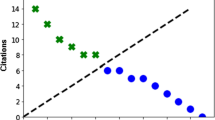Abstract
One interesting phenomenon that emerges from the typical structure of social networks is the friendship paradox. It states that your friends have on average more friends than you do. Recent efforts have explored variations of it, with numerous implications for the dynamics of social networks. However, the friendship paradox and its variations consider only the topological structure of the networks and neglect many other characteristics that are correlated with node degree. In this article, we take the case of scientific collaborations to investigate whether a similar paradox also arises in terms of a researcher’s scientific productivity as measured by her H-index. The H-index is a widely used metric in academia to capture both the quality and the quantity of a researcher’s scientific output. It is likely that a researcher may use her coauthors’ H-indexes as a way to infer whether her own H-index is adequate in her research area. Nevertheless, in this article, we show that the average H-index of a researcher’s coauthors is usually higher than her own H-index. We present empirical evidence of this paradox and discuss some of its potential consequences.



Similar content being viewed by others
References
Alves, B. L., Benevenuto, F., & Laender, A. H. F. (2013). The role of research leaders on the evolution of scientific communities. In Proceedings of the 22nd international conference on world wide web (companion volume) (pp. 649–656).
Barabási, A. L., & Albert, R. (1999). Emergence of scaling in random networks. Science, 286(5439), 509–512.
Bornmann, L., & Daniel, H. D. (2005). Does the h-index for ranking of scientists really work? Scientometrics, 65(3), 391–392.
Centola, D. (2010). The spread of behavior in an online social network experiment. Science, 329(5996), 1194–1197.
Eom, Y. H., & Jo, H. H. (2014). Generalized friendship paradox in complex networks: The case of scientific collaboration. Scientific Reports, 4. http://www.nature.com/articles/srep04603.
Feld, S. L. (1991). Why your friends have more friends than you do. American Journal of Sociology, 96(6), 1464–1477.
Giansante, S., Kirman, A., Markose, S., & Pin, P. (2007). The grass is always greener on the other side of the fence: The effect of misperceived signalling in a network formation process. In A. Consiglio (Ed.), Artificial markets modeling: Methods and applications. Lecture notes in economics and mathematical systems (Vol. 599, pp. 223–234). Berlin: Springer.
Hirsch, J. E. (2005). An index to quantify an individual’s scientific research output. Proceedings of the National Academy of Sciences of the United States of America, 102(46), 16569–16572.
Hodas, N. O., Kooti, F., & Lerman, K. (2013). Friendship paradox redux: Your friends are more interesting than you. In Proceedings of the international conference on web and social media (pp. 8–10).
Hodas, N. O., Kooti, F., & Lerman, K. (2014). Network weirdness: Exploring the origins of network paradoxes. In Proceedings of the international conference on web and social media (pp. 8–10).
Huang, J., Zhuang, Z., Li, J., & Giles, C. L. (2008). Collaboration over time: Characterizing and modeling network evolution. In Proceedings of the 2008 international conference on web search and data mining (pp. 107–116).
Lerman, K., Yan, X., & Wu, X. Z. (2015). The majority illusion in social networks. arXiv:1506.03022.
Mislove, A., Marcon, M., Gummadi, K. P., Druschel, P., & Bhattacharjee, B. (2007). Measurement and analysis of online social networks. In Proceedings of the 7th ACM SIGCOMM conference on internet measurement (pp. 29–42).
Salganik, M. J., Dodds, P. S., & Watts, D. J. (2006). Experimental study of inequality and unpredictability in an artificial cultural market. Science, 311(5762), 854–856.
Acknowledgments
This research was partially funded by InWeb—The Brazilian National Institute of Science and Technology for the Web (MCT/CNPq/FAPEMIG Grant 573871/2008-6), and by the authors’ individual grants from CAPES, CNPq and FAPEMIG.
Author information
Authors and Affiliations
Corresponding author
Rights and permissions
About this article
Cite this article
Benevenuto, F., Laender, A.H.F. & Alves, B.L. The H-index paradox: your coauthors have a higher H-index than you do. Scientometrics 106, 469–474 (2016). https://doi.org/10.1007/s11192-015-1776-2
Received:
Published:
Issue Date:
DOI: https://doi.org/10.1007/s11192-015-1776-2




